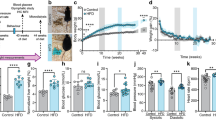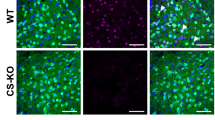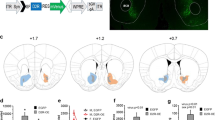Abstract
High-energy diets that induce obesity decrease striatal dopamine D2/3 receptor (DRD2/3) availability. It is however poorly understood which components of these diets are underlying this decrease. This study assessed the role of saturated fat intake on striatal DRD2/3 availability. Forty rats were randomized to a free-choice high-fat high-sugar diet (HFHS) or a standard chow diet for 28 days. Striatal DRD2/3 availability was measured using 123I-IBZM storage phosphor imaging at day 29. The HFHS group was split in a HFHS-high-fat (HFHS-hf) and HFHS-low-fat (HFHS-lf) group based on the percentage energy intake from fat. Rats of both HFHS subgroups had increased energy intake, abdominal fat stores and plasma leptin levels compared with controls. DRD2/3 availability in the nucleus accumbens (NAcc) was significantly lower in HFHS-hf than in HFHS-lf rats, whereas it was similar for HFHS-lf and control rats. Furthermore, DRD2/3 availability in the NAcc was positively correlated with the percentage energy intake from sugar. Total energy intake was lower for HFHS-hf than for HFHS-lf rats. Together these results suggest that a diet with a high fat/carbohydrate ratio, but not total energy intake or the level of adiposity, is the best explanation for the decrease in striatal DRD2/3 availability observed in diet-induced obesity.
This is a preview of subscription content, access via your institution
Access options
Subscribe to this journal
Receive 12 print issues and online access
$259.00 per year
only $21.58 per issue
Buy this article
- Purchase on Springer Link
- Instant access to full article PDF
Prices may be subject to local taxes which are calculated during checkout

Similar content being viewed by others
References
Johnson PM, Kenny PJ . Dopamine D2 receptors in addiction-like reward dysfunction and compulsive eating in obese rats. Nat Neurosci 2010; 13: 635–641.
Huang XF, Zavitsanou K, Huang X, Yu Y, Wang H, Chen F et al. Dopamine transporter and D2 receptor binding densities in mice prone or resistant to chronic high fat diet-induced obesity. Behav Brain Res 2006; 175: 415–419.
van de Giessen E, La Fleur SE, de Bruin CM, van den Brink W, Booij J . Free-choice and no-choice high fat diets affect striatal dopamine D2/3 receptor availability, caloric intake, and adiposity. Obesity (Silver Spring) 2012. e-pub ahead of print 6 February 2012 doi:10.1038/oby.2012.17.
Wang GJ, Volkow ND, Logan J, Pappas NR, Wong CT, Zhu W et al. Brain dopamine and obesity. Lancet 2001; 357: 354–357.
de Weijer BA, van de Giessen E, van Amelsvoort TA, Boot E, Braak B, Janssen IM et al. Lower striatal dopamine D2/3 receptor availability in obese compared with non-obese subjects. EJNMMI Res 2011; 1: 37.
Davis JF, Choi DL, Schurdak JD, Fitzgerald MF, Clegg DJ, Lipton JW et al. Leptin regulates energy balance and motivation through action at distinct neural circuits. Biol Psychiatry 2011; 69: 668–674.
La Fleur SE, van Rozen AJ, Luijendijk MC, Groeneweg F, Adan RA . A free-choice high-fat high-sugar diet induces changes in arcuate neuropeptide expression that support hyperphagia. Int J Obes (Lond) 2010; 34: 537–546.
Kalsbeek A, Fliers E, Romijn JA, La Fleur SE, Wortel J, Bakker O et al. The suprachiasmatic nucleus generates the diurnal changes in plasma leptin levels. Endocrinology 2001; 142: 2677–2685.
Crunelle CL, Miller ML, de Bruin K, van den Brink W, Booij J . Varenicline increases striatal dopamine D2/3 receptor binding in rats. Addict Biol 2009; 14: 500–502.
van de Giessen E, de Bruin K, La Fleur SE, van den Brink W, Booij J . Triple monoamine inhibitor tesofensine decreases food intake, body weight, and striatal dopamine D2/D3 receptor availability in diet-induced obese rats. Eur Neuropsychopharmacol 2012; 22: 290–299.
Lenoir M, Serre F, Cantin L, Ahmed SH . Intense sweetness surpasses cocaine reward. PLoS One 2007; 2: e698.
Hajnal A, Norgren R . Accumbens dopamine mechanisms in sucrose intake. Brain Res 2001; 904: 76–84.
Geiger BM, Haburcak M, Avena NM, Moyer MC, Hoebel BG, Pothos EN . Deficits of mesolimbic dopamine neurotransmission in rat dietary obesity. Neuroscience 2009; 159: 1193–1199.
Morris JK, Bomhoff GL, Gorres BK, Davis VA, Kim J, Lee PP et al. Insulin resistance impairs nigrostriatal dopamine function. Exp Neurol 2011; 231: 171–180.
Opland DM, Leinninger GM, Myers MG . Modulation of the mesolimbic dopamine system by leptin. Brain Res 2010; 1350: 65–70.
Odorizzi M, Max JP, Tankosic P, Burlet C, Burlet A . Dietary preferences of Brattleboro rats correlated with an overexpression of galanin in the hypothalamus. Eur J Neurosci 1999; 11: 3005–3014.
Akabayashi A, Koenig JI, Watanabe Y, Alexander JT, Leibowitz SF . Galanin-containing neurons in the paraventricular nucleus: a neurochemical marker for fat ingestion and body weight gain. Proc Natl Acad Sci USA 1994; 91: 10375–10379.
Adams AC, Clapham JC, Wynick D, Speakman JR . Feeding behaviour in galanin knockout mice supports a role of galanin in fat intake and preference. J Neuroendocrinol 2008; 20: 199–206.
Rada P, Mark GP, Hoebel BG . Galanin in the hypothalamus raises dopamine and lowers acetylcholine release in the nucleus accumbens: a possible mechanism for hypothalamic initiation of feeding behavior. Brain Res 1998; 798: 1–6.
Acknowledgements
We thank José van den Heuvel for her help with the body weight and energy intake measurements and Els Johannesma-Brian for plasma leptin measurements.
Author information
Authors and Affiliations
Corresponding author
Ethics declarations
Competing interests
JB is consultant at GE Healthcare, The Netherlands. The remaining authors declare no conflict of interest.
Additional information
Supplementary Information accompanies the paper on International Journal of Obesity website
Supplementary information
Rights and permissions
About this article
Cite this article
van de Giessen, E., la Fleur, S., Eggels, L. et al. High fat/carbohydrate ratio but not total energy intake induces lower striatal dopamine D2/3 receptor availability in diet-induced obesity. Int J Obes 37, 754–757 (2013). https://doi.org/10.1038/ijo.2012.128
Received:
Revised:
Accepted:
Published:
Issue Date:
DOI: https://doi.org/10.1038/ijo.2012.128
Keywords
This article is cited by
-
Dopaminergic Pathways in Obesity-Associated Inflammation
Journal of Neuroimmune Pharmacology (2020)
-
Dopamine and diet-induced obesity
Nature Neuroscience (2019)
-
The dopamine motive system: implications for drug and food addiction
Nature Reviews Neuroscience (2017)
-
Hormonal and neural mechanisms of food reward, eating behaviour and obesity
Nature Reviews Endocrinology (2014)



